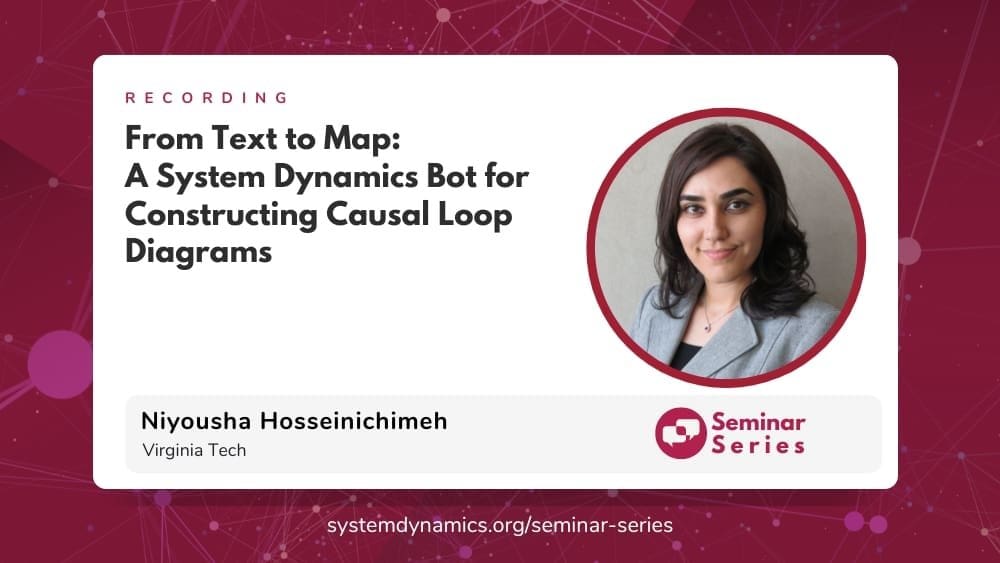From Text to Map: A System Dynamics Bot for Constructing Causal Loop Diagrams
We had an insightful webinar titled “From Text to Map: A System Dynamics Bot for Constructing Causal Loop Diagrams.” The session, led by Niyousha Hosseinichimeh, explored the capabilities and challenges of a novel tool designed to automate the creation of causal loop diagrams (CLDs) from textual data. Here are the key takeaways from the presentation:
Overview of the System Dynamics Bot
The System Dynamics Bot aims to automate the process of constructing CLDs from text, leveraging large language models and generative artificial intelligence. Niyousha Hosseinichimeh emphasized the tool’s potential by stating, “The System Dynamics Bot can streamline the modeling process, making it less labor-intensive and more efficient.”
- Capabilities of Large Language Models: The bot uses deep learning techniques to process and interpret text, identifying causal relationships and constructing CLDs. This demonstrates the potential of large language models in system dynamics and model building.
- Effectiveness and Practical Examples: Practical examples during the webinar showcased the bot’s ability to convert textual data into causal loop diagrams, effectively capturing significant feedback loops and causal links. Hosseinichimeh noted, “This tool offers a novel way to enhance our understanding of complex systems by automating the creation of causal loop diagrams.”
Evaluation of the Bot’s Performance
Two data sets were used for evaluation:
- Data Set One: Included 20 CLDs from system dynamics literature, capturing 60% of causal links and 66% of feedback loops on average.
- Data Set Two: Included responses from 30 individuals, with the bot capturing 56% of causal relationships and 83% of feedback loops.
Applications and Future Directions
The bot can significantly save time and effort in developing CLDs, assisting both novice modelers and experienced practitioners. Potential applications include:
- Educational Tools: Enhancing the learning experience for system dynamics students.
- Group Model Building: Supporting the creation of causal loop diagrams during group sessions.
- Comparative Studies: Comparing human-generated and AI-generated models to improve accuracy and insights.
- Literature Review-Based CLDs: Synthesizing information from various fields to create comprehensive diagrams.
- Mapping Mental Models: Analyzing how different individuals perceive complex issues.
Hosseinichimeh highlighted, “This program can be used to generate literature review-based causal loop diagrams and aid in group model building sessions,” showcasing its versatility and practical benefits.
Watch the full webinar recording below. It provides in-depth insights into the development, functionality, and applications of the System Dynamics Bot, showcasing its potential to revolutionize how we construct and interpret causal loop diagrams.
Watch the recording below
Whoops, this recording is available for members and ticket purchasers only. Please login to verify. If you’re not a member, purchase a membership here. You can also buy a ticket to watch the recording here.
PRESENTERS
Niyousha Hosseinichimeh has a PhD and a master’s degree in public administration and policy from State University of New York at Albany, and a bachelor’s degree in mechanical engineering from Sharif University, Iran. She is currently an assistant professor at the Department of Industrial and Systems Engineering at Virginia Tech. Her research focuses on developing and applying methods to improve health and healthcare systems. She uses simulation models to help stakeholders improve their understanding and decision making in complex dynamic systems. She has applied system dynamics approach to diverse health issues including infant mortality, mental health, and alcohol impaired driving among teens. Her methodological contributions include expanding calibration methods for dynamic models and developing techniques for system dynamics group model building. Her research has been funded by the National Institute of Health, National Science Foundation, Agency for Healthcare Research and Quality, Ohio State Department of Health, and Burroughs Wellcome Fund.
Recent Posts
Society Governance Updates
New System Dynamics Society leadership
Call for Presenters: Seminar Series
Share your insights in the System Dynamics Society Seminar Series. Submit your proposal and join a global community of experts
Honoring Excellence: A Glimpse into the Awards of the International System Dynamics Conference
Dive into the prestigious awards and honorable mentions of the International System Dynamics Conference, celebrating trailblazers and emerging talents in the field
Upcoming Events

2024 International System Dynamics Conference
The International System Dynamics Conference is coming to Bergen! Save the date: August 4-8, 2024. We hope to see you there! #ISDC2024
Recent Business cases
System Dynamics Helps Evaluate Anticipatory Action on Cholera Outbreaks
Humanitarian agencies encourage anticipatory action in disaster response to cholera outbreaks in the Democratic Republic of Congo.
Management Design for Planted Forests in Japan Using System Dynamics
Hanno City in Saitama Prefecture used a system dynamics model to enable detailed analysis of labor requirements and changes in forest conditions.
Solving Bottlenecks in Dairy Production Facilities with System Dynamics
FriedslandCampina employed system dynamics to strategically enhance production efficiency in the midst of factory merging.


